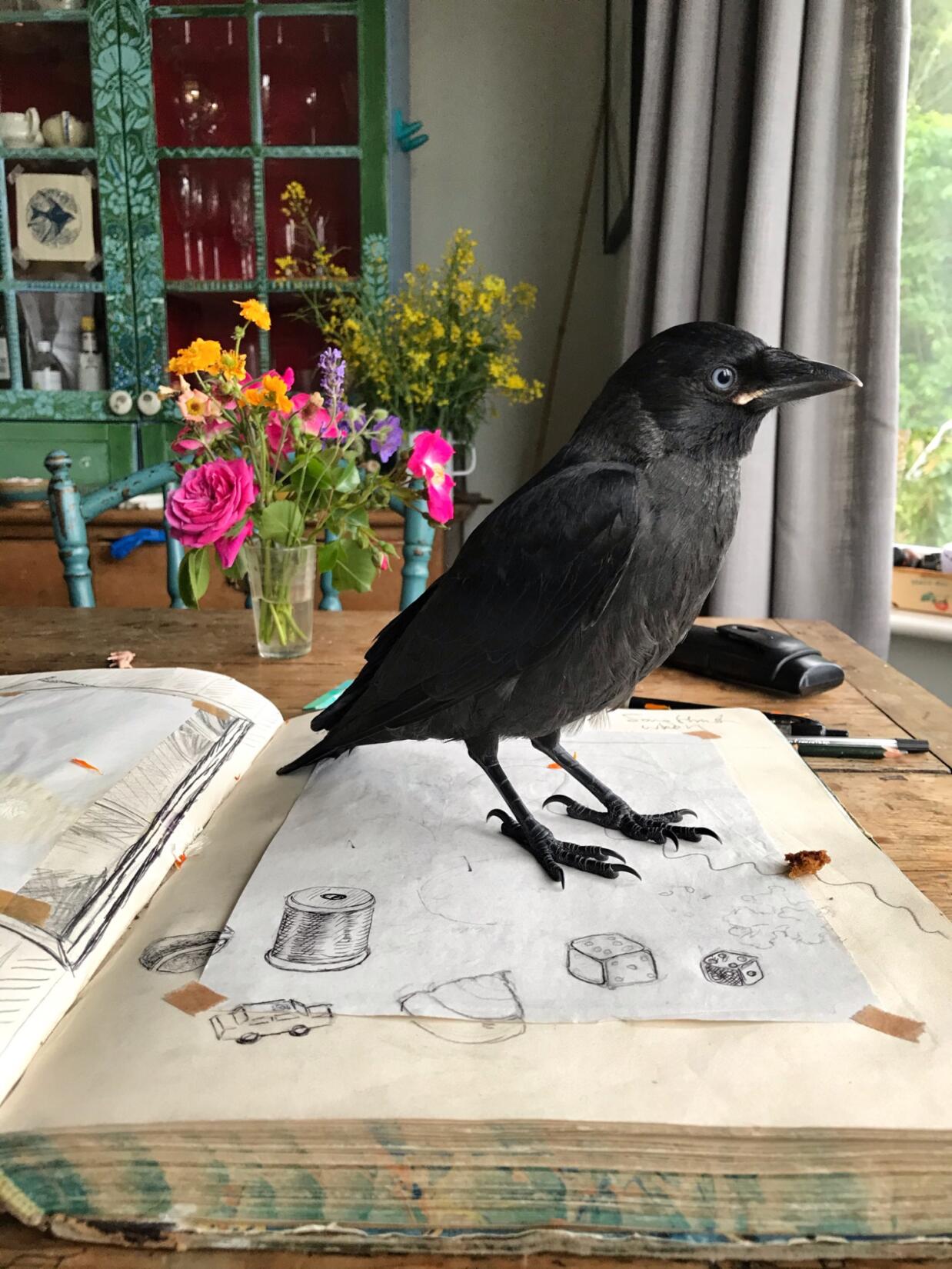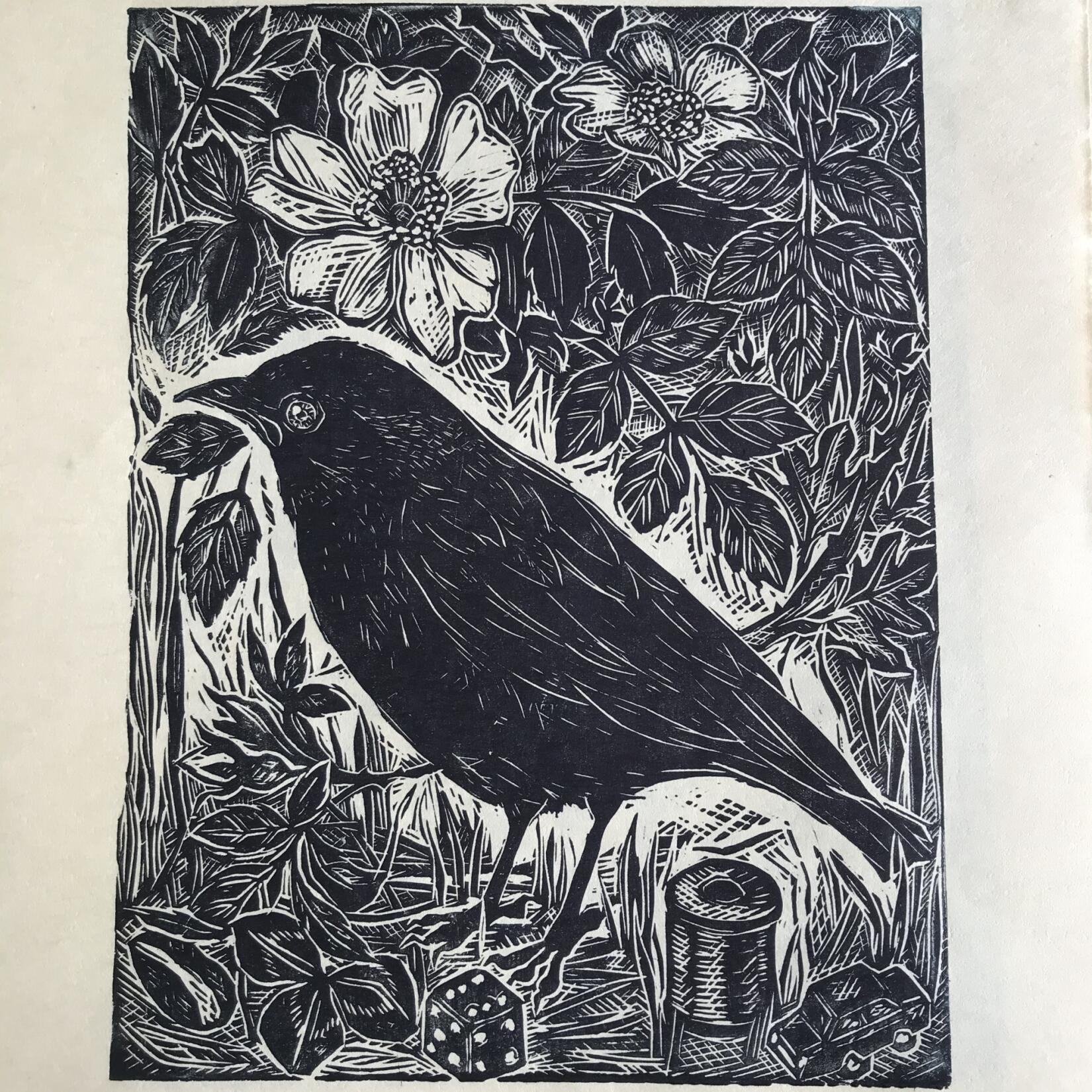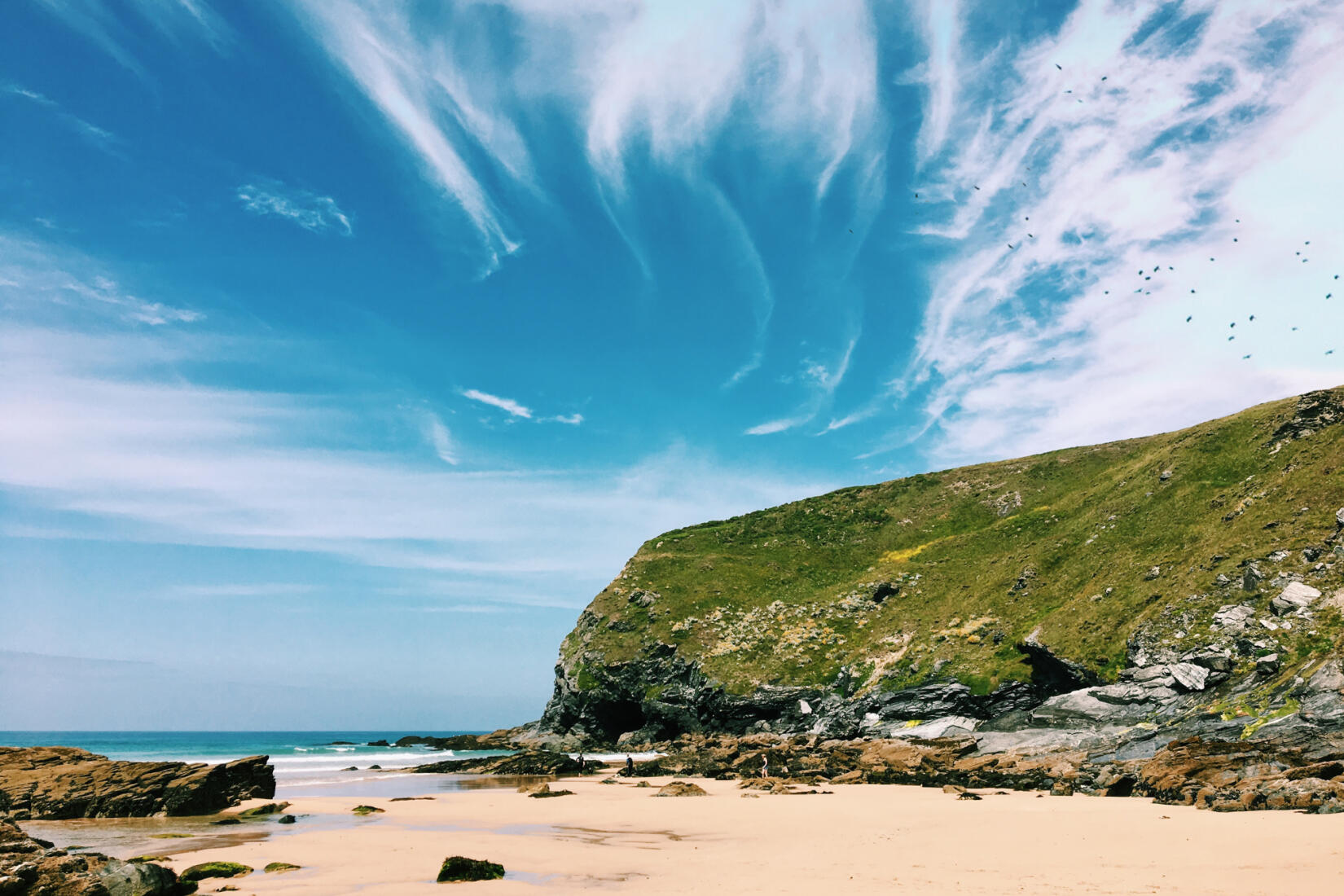A clattering in the sky
Our bright-eyed neighbours, the jackdaws’ cries from the cliff face are a familiar sound around these parts. We spoke to local ecologist and lecturer John Blackburn to learn more about our local colony – from facial recognition, to high level showing off. Cornwall-based printmaker and artist Lou Tonkin also shares a touching story about hand-rearing a baby jackdaw (who developed a habit of stealing her pens).
This patch of ours, from Porth to Watergate Bay, teems with life lived on every level. Lapping waves to tidal pools, cliff-face to coastal path, grassland to farmland: habitats are stacked one above the other, host to a myriad of species. And like the Bay’s human community, there are locals and guests. Some come passing through, others return year on year. Birds are blown in from the Atlantic, creatures wash in and out with the tide. But it’s the jackdaws that keep the home fires burning.
...but it's the jackdaws who are the real residents of Watergate Bay.
— John Blackburn
For those who call the bay home, the ‘kya’s’ and ‘ca ca cas’ of the jackdaws’ call are as familiar as the crash of the swell on a windy day. All year round, a colony, or ‘clattering’ – to use the apt collective noun – make their home here, nesting in the cracks on the cliff and nooks around the hotel building. Head out with a surfboard and you’ll probably hear them from the line-up, egging you on.
John Blackburn is a Newquay local and lecturer in ecology at Cornwall College, so he knows the black-winged rabble well. “Other birds might migrate, or disappear off to sea,” he says fondly, “but the jackdaws are the real residents of Watergate Bay.”
Getting to know them
Jackdaw, jackerdaw, Jac-y-do, sea crow, ka-wattie, chimney sweep bird. These small black corvids are found all over Europe, Western Asia, and North Africa – and go by many affectionate names. Alongside their distinctive call, you can spot a jackdaw by its silvery-grey head feathers, and bright white curious eyes. They’re into people, and you’re unlikely to pass a day in the Bay without meeting one.
Jackdaws are sociable, and loud…and known for human interaction. They’re very clever and can tell human faces apart, which is advanced for any animal
“Jackdaws are sociable, and loud,” John says. “And known for human interaction… They’re very clever and can tell human faces apart, which is advanced for any animal.” There are countless tales of tame jackdaws who’ve formed close bonds with humans; and their intelligence allows them to build communities with a strong social hierarchy, and couple up for life.
“At Watergate, you get colonies of pairs of birds and their young, living together like a little town,” John says. “They can signal to each other where food is, and when they come back to their nest, the male will shout down the hole, or the chimney, where they’ve made their home – and the female will give a little purr in response.”
Food for a jackdaw is whatever they can find, and it’s their resourcefulness and communal lifestyle that keeps them here through the winter, foraging for grubs, crumbs, seeds or roadkill. They’re not fussy, and footfall to and from the hotel keeps them scrounging around in the hope of tasty scraps. “For all the impressive masonry and architecture here, all they see is another cliff face,” says John. “They’ll quite happily live closely alongside us.”
Playing the fool
It’s worth keeping a particular eye out for the jackdaws in spring, when they begin to flirt and show off. “Around March and April they tend to start displaying,” John explains, “flying up high in the air and then dropping down and doing a twirl. It looks like they're playing, but they're trying to mate. Although sometimes the young birds do it as well, for practice!”
Despite their aerial acrobatics, Jackdaws don’t have a glamorous reputation. “They're not big compared to other crows, or agile like starlings, and they don't tend to fly great distances,” says John. Perhaps it’s their twirling tumbles and laughing cries that have traditionally cast them as the tricksters and fools of folklore. In old English dialect, ‘daw’ is a playfully derogatory term for an idiot, and Aesop’s fables tell of silly jackdaws who wait for figs to ripen, or vainly dress in peacock feathers.
Folklore variously suggests that if you spot one on the way to a wedding it’s a good sign, but one on the roof is a portent of death. The Roman poet Ovid writes that spotting a jackdaw means rain is on the way, and in Wales – thanks to their habit of nesting in churches – they’ve been believed to keep the Devil at bay. Like their magpie cousins, jackdaws have also gained a reputation for making off with shiny trinkets, and their Latin name Corvus monedula comes from the Latin for money.
Remembering to look up
But what does a jackdaw on our cliffs mean? For us, they’re the sign we’re home, our personal guides to a diverse community that lives just above our eyeline. Follow the friendly call of the jackdaws and look to the sky – there’s no telling what else you might see, or who else you might hear.
“If you venture past the hotel into the quieter areas, you can usually see fulmars and their nests on the cliffs from the beach, and sometimes you’ll see a chick too,” says John. “Up on the path there is a range of farmland birds to spot, including the corn bunting – which is a declining species. All sorts of seabirds shelter here during bad storms, and you might see gannets flying in a line across the bay.”
You might also see the peregrine falcons that have made their home here, and the falcon fledglings that have just taken flight. “They fly almost like a cross in the sky, with straight wings, head and tail – and they fly very fast,” John says, telling us too about the ocean-going shearwaters that pass through in the summer, and the dainty stonechats – tiny orange-breasted songbirds that line the coast-path – that you’re sure to see, chirping above the heather and gorse.
The best birds John’s ever seen in Cornwall? “It was right near here, on Porth island,” he says, wistfully. “I suddenly saw a pair of choughs [the very rare, red-beaked emblems of Cornwall]. It was so great because it was just so unexpected, and so close to home.”
It’s this reminder that there’s a world of life in and around Watergate Bay, if you know how to pay attention. The next time you hear the jackdaws cackling, why not listen to what they’re trying to say?
John is the programme manager for the FdSc Conservation and Ecology Programme and the BSC(Hons) Environmental Resource Management degree at Cornwall college Newquay, and is a lecturer in Ecology, Conservation and Environmental planning.
Lou Tonkin
Fledgling inspiration
Lou Tonkin is an artist and printmaker based in Mylor, Cornwall. When a baby jackdaw fell down her chimney in the spring, it was the beginning of a touching relationship that sparked a new print design (featured below), as well as laughter, mischief, tears and stolen pens…
“It’s a really instinctive thing, looking after a baby animal,” says Lou. “It didn’t feel difficult. We had the most incredible bond. It absolutely knew us, and knew me as its ‘mum’.
“Its parents did stay around though – part of the ease of getting it back out there as a wild bird, was that its parents were amazingly loyal. As a baby, there was nothing we could do to reintroduce it before it could fly or walk – so we had to keep feeding it inside, then take it outside to show its parents it was still there. They stayed around and kept calling to it. When it was big enough, we kept putting it outside. It was terrified at first! Then one day, the mother flew down, called to it and it followed her… and they flew off together. But it stayed around for a long time with the parents afterwards – you could see them leading it to our garden to be fed.
“They definitely recognise faces. My partner was away for a couple of weeks, and when he came back, it was clearly cross with him. Maybe it was to do with feelings of abandonment or him coming back – who knows? But the communication and recognition is really clear and obvious.
“The baby jackdaw really liked coming into my workshop, too. But if I was really absorbed in my work, and couldn’t give it enough attention, sometimes there would be some deliberate mischief… tearing prints off the walls! But they play a lot too. Anytime I was drawing at the table, it would run off with my pens. It gave us hours of entertainment.


Discover Lou Tonkin
Discover more
Be the first to know
We'd love to keep in touch and send you the latest news, events, competitions and offers from the Bay. Sign up to receive our e-newsletter.

